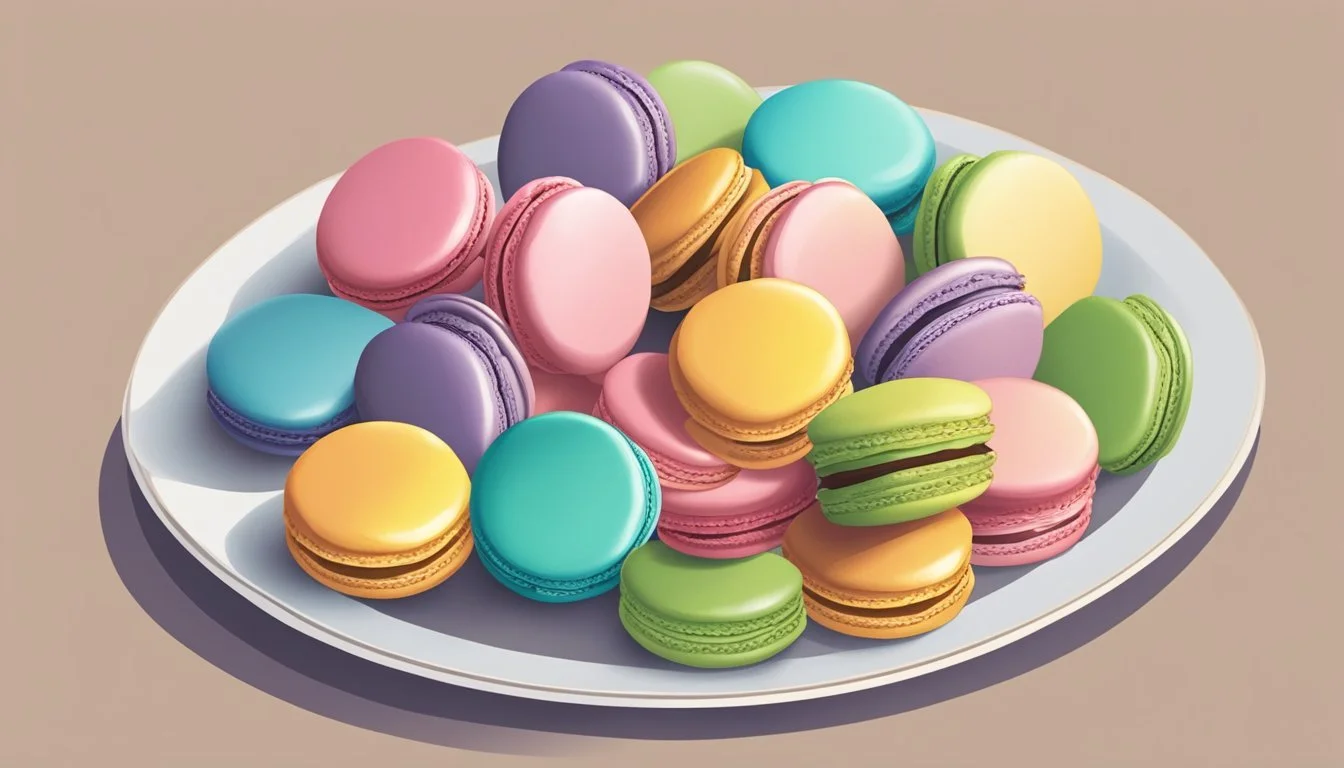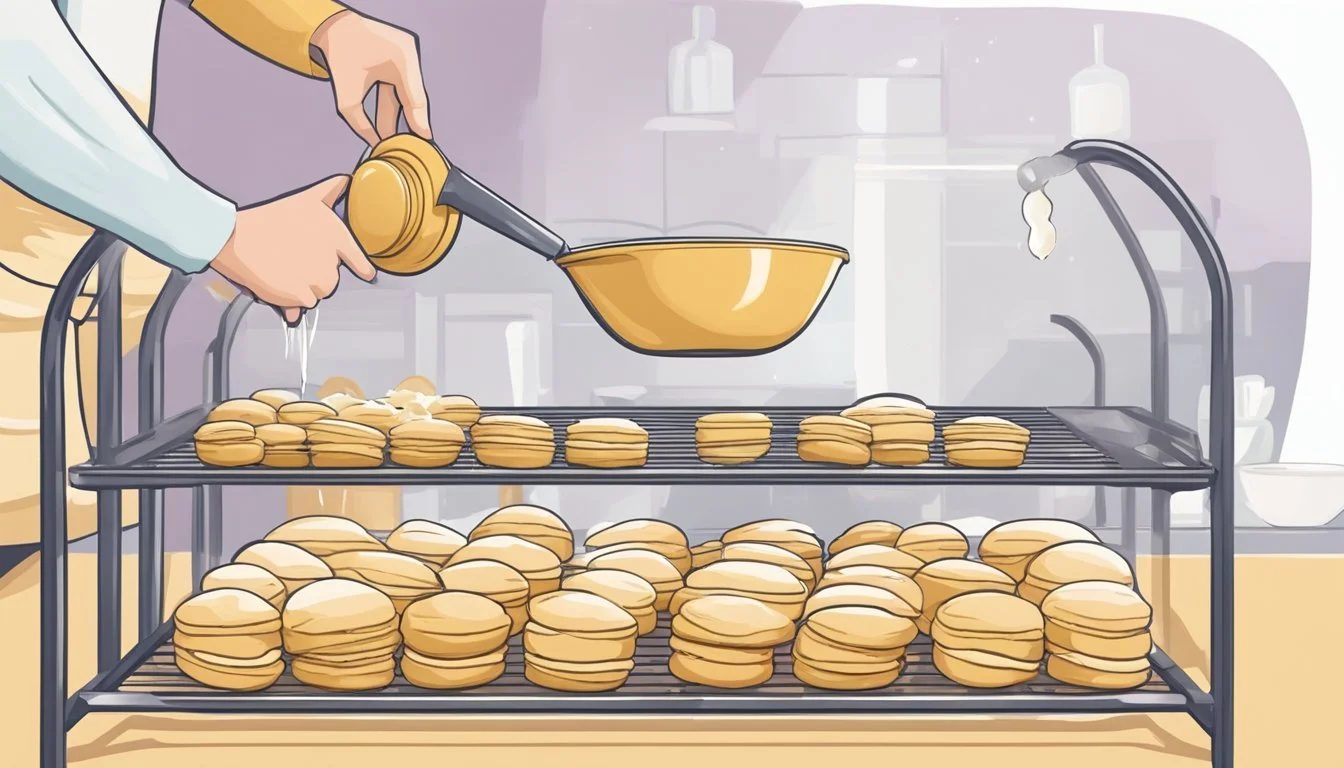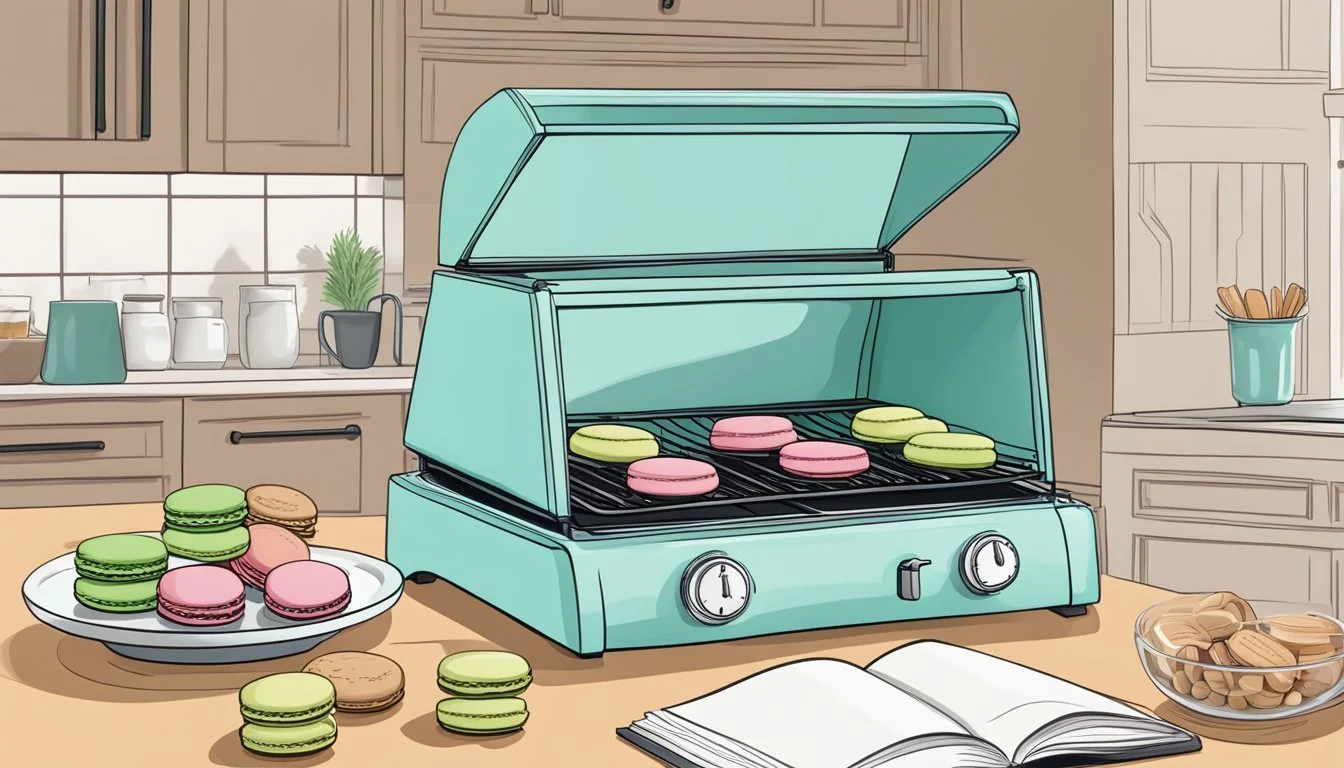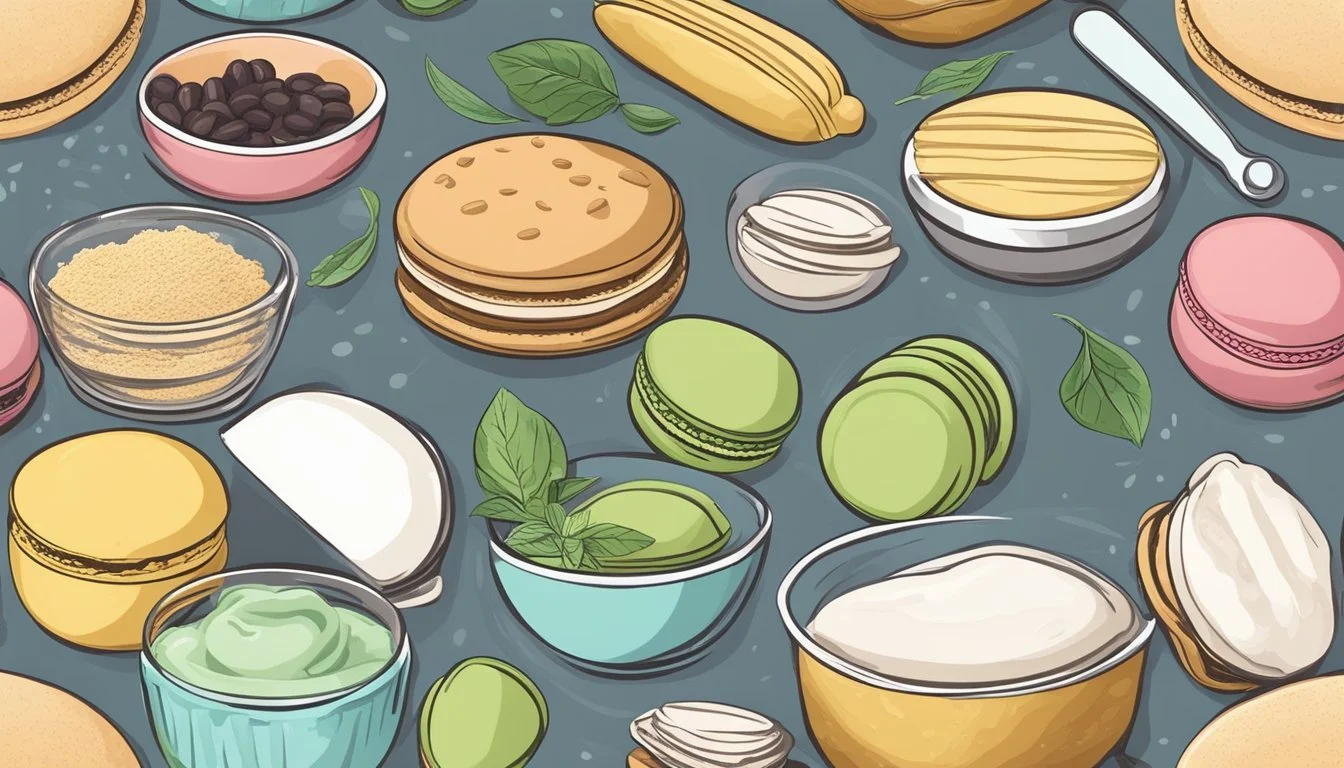Are Macarons Vegan?
Unveiling the Truth About These French Confections
Macarons, the delicate French confections known for their vibrant colors and irresistible texture, have long captivated the palates of sweet-toothed enthusiasts around the world. These treats are traditionally made from a base of almond flour, confectioners' sugar, and egg whites, with a creamy filling that often includes dairy. The presence of egg whites and dairy-based ingredients in most macaron recipes means that they are not suitable for a vegan diet, which excludes all animal products.
There is, however, growing interest in vegan baking which has led to the creation of vegan macarons. These plant-based versions of the classic macaron seek to replicate the characteristic crisp exterior and chewy interior without the use of eggs or dairy. Vegan macarons are typically made using ingredients like aquafaba, which is the liquid from canned chickpeas, as an egg white substitute, along with plant-based food colorings and flavors.
The art of making vegan macarons can be challenging due to the precise nature of traditional macaron baking, yet it is a testament to the versatility of vegan baking. As demand for inclusive dessert options rises, the development of vegan macarons represents a significant step toward accommodating those who follow a vegan lifestyle or have dietary restrictions such as allergies to eggs or dairy.
What Makes Macarons Vegan
Vegan macarons encompass specific ingredient swaps to align with plant-based diets while attempting to replicate the delicate texture and taste of traditional macarons.
Understanding the Basics of Macarons
Macarons are a popular confection known for their smooth tops, ruffled edges (known as "feet"), and rich filling. The characteristic texture and appearance of macarons come from the specific method of preparing the meringue and almond flour mixture.
A Look at Traditional Ingredients
Traditional Macaron Ingredients:
Egg Whites: Provide structure and aeration.
Almond Flour: The nut base for the cookie.
Icing Sugar: Sweetens and binds the cookies.
Butter or Cream: Often used in the filling.
Key Vegan Substitutes
To create vegan macarons, bakers substitute each animal-derived ingredient with a plant-based alternative while maintaining the integrity of the cookie's texture.
Egg Substitute: Aquafaba, the liquid from canned chickpeas, is the most common vegan egg replacement due to its ability to mimic the properties of egg whites when whipped into a meringue.
Traditional Ingredient Vegan Substitute Egg Whites Aquafaba Butter/Cream Vegan Butter
Almond Flour and Icing Sugar: These ingredients are inherently vegan-friendly and commonly remain unchanged in vegan macaron recipes.
Vegan Macaron: A confectionery masterpiece that encompasses the essence of a traditional macaron with plant-based components.
Crafting the Vegan Meringue
In the creation of vegan macarons, the meringue takes center stage as it provides the necessary structure and lightness. Aquafaba, cream of tartar, and lemon juice are pivotal in achieving the consistency of traditional meringue without using egg whites.
Role of Aquafaba
Aquafaba, the liquid from cooked chickpeas, serves as an excellent plant-based substitute for egg whites in vegan meringue. It contains proteins and carbohydrates which help it mimic the binding and aerating properties of egg whites. To use aquafaba, one typically drains the liquid from canned chickpeas and whisks it until frothy.
Achieving Stiff Peaks
One must whip the aquafaba vigorously to turn it into a foam capable of reaching stiff peaks. Stiff peaks are indicated by the mixture standing up firmly when the whisk is lifted. For added stability, some people add sugar while whisking to thicken the consistency and ensure the meringue is strong enough to support the macaron shells.
Incorporating Cream of Tartar
Adding a small amount, typically around 1 teaspoon of cream of tartar or a few drops of lemon juice, can stabilize the aquafaba meringue. These acidic ingredients act as a stabilizing agent, increasing the mixture's acidity, which helps achieve and hold stiff peaks. It is crucial for giving the meringue structure and making it less prone to deflating during mixing and baking.
The Macaronage Technique
The macaronage technique is critical in making macarons as it involves the careful folding of dry ingredients into meringue to achieve the hallmark smooth, shiny surface and characteristic 'feet'. Precise execution is vital to the success of this delicate pastry.
Combining Dry and Wet Ingredients
When combining the dry ingredients, typically almond flour and powdered sugar, with the wet, usually a meringue, the baker uses a spatula to gently fold the mixture. One must ensure that the dry ingredients are fully integrated without deflating the meringue. The process involves cutting through the mixture, scooping from the bottom, and folding over, turning the bowl as one works.
Achieving the Perfect Texture
The texture of the macaron batter should flow like lava; not too runny and not too stiff. An effective macaronage technique involves folding until the batter ribbons off the spatula. Watching for the batter to reach the stage where it flattens slowly, leaving no air bubbles, is crucial. Under-mixing leaves the batter lumpy and over-mixing can cause the batter to become too thin, leading to flat and shapeless macarons.
Importance of Folding
Folding is more than just mixing; it's about ensuring the right consistency while preserving air in the meringue. The folding method significantly affects the development of feet and prevents air bubbles, which can cause the surfacing of the shells to crack in the oven. Usually, 35 to 40 folds are enough, but the key indicator is batter texture rather than a specific number.
Baking and Temperature Control
Accurate temperature control is crucial in baking macarons, as it is the key to achieving the characteristic "feet" and preventing issues like cracking. An oven thermometer and stable temperature ensure consistent results.
Oven Preparation
Before baking macarons, it is essential that the oven is properly prepared. This involves:
Ensuring the oven is thoroughly preheated to avoid temperature fluctuations.
Using an oven thermometer to verify the actual oven temperature, as built-in thermostats may be inaccurate.
Positioning baking trays strategically to avoid hot spots which can lead to uneven baking.
Monitoring the Temperature
The role of temperature monitoring cannot be overstated when baking macarons. Bakers should:
Keep a vigilant eye on the oven thermometer throughout the baking process.
Adjust the oven settings if deviations from the optimal temperature range are observed.
Be aware of how humidity and other environmental factors can affect internal oven temperature.
Understanding Feet Formation
The formation of "feet," the frilly edges at the base of the macaron, is a hallmark of successful baking. To facilitate this:
Maintain a stable temperature within the oven, as fluctuations can prevent feet from developing.
Ensure the batter is properly rested and the baking tray is not overcrowded, which can affect heat circulation.
Recognize that the correct temperature helps to create the lift and structure necessary for feet to form without causing the tops to crack.
Vegan Filling Options
Creating vegan macarons involves not only replacing egg whites in the shells but also ensuring the fillings are plant-based. These fillings deliver the same lush textures and rich flavors as traditional macaron fillings without any animal-derived ingredients.
Buttercream Alternatives
Vegan buttercream is the cornerstone of many macaron fillings. It can be made using solid vegan butter, combined with powdered sugar and flavored with pure vanilla extract. It's important to beat them well until light and fluffy for the ideal consistency. To enhance the filling, one could weave in fruit purees, such as raspberry, to add a zesty note.
Chocolate Ganache with Vegan Creams
For a rich and velvety filling, a vegan chocolate ganache can be prepared using high-quality dark chocolate and a plant-based cream, like coconut cream, which imparts a subtle tropical flavor. Melt the two together and stir until smooth. This ganache can be used both as a filling and a chocolate coating, ensuring a decadent experience.
Using Fruit-Flavored Fillings
Fruit flavors add a bright and refreshing contrast to the sweetness of macarons. By taking advantage of seasonal fruits or high-quality preserves, one can create vibrant fillings. A simple mixture of fruit reduction and vegan spread can achieve a satisfyingly smooth consistency, perfect for piping onto macaron shells.
Decorating and Presentation
The decoration and presentation of macarons transform them from simple cookies to delectable pieces of art. Precise application of color and flavor ensures each macaron is as delightful to look at as it is to eat, and assembling them with care underlines their classic elegance. Serving suggestions play a crucial role in enhancing the experience of enjoying these dainty desserts.
Applying Color and Flavor
To add vibrant colors to macarons, one can use gel food coloring which provides intense shades without affecting the consistency of the batter. The coloring is typically added during the macaronage phase, where the almond flour and meringue are folded together. It's important to use gel or powder colorants rather than liquid, as the extra moisture can ruin macarons' texture. When incorporating the coloring, it's also the perfect time to mix in any flavouring. Extracts or zest can impart an extra dimension of taste, complementing the filling that will later be sandwiched between the shells.
Common Color and Flavor Combinations:
Red: Strawberry or raspberry flavor
Green: Pistachio or matcha flavor
Yellow: Lemon or mango flavor
Brown: Chocolate or coffee flavor
Assembling Macarons
Once the shells are baked and cooled, they are paired by size and ready to be assembled. A piping bag fitted with a round tip is the tool of choice for adding fillings like buttercream, ganache, or fruit preserves. It's critical to pipe the filling onto one shell before gently sandwiching it with its pair. This not only ensures even distribution of the filling but also creates the iconic macaron silhouette with the ruffled edge or 'foot'.
Assembly Steps:
Match macaron shells by size.
Prepare the piping bag with chosen filling.
Pipe a dollop on the flat side of one shell.
Gently press its pair on top.
Serving Suggestions
To elevate the presentation of macarons, one might present them on a simple, elegant platter, or for a more opulent touch, intersperse them with small chocolates or dust with edible glitter. The key is to showcase the macarons in a way that complements their decor without overshadowing their natural appeal. When serving, consider the setting: for a formal event, a tiered stand adds height and grandeur, while for a casual gathering, a colorful arrangement on a flat tray invites guests to help themselves.
Presentation Tips:
For formal events, use tiered stands.
For casual affairs, present on a vibrant, flat tray.
Accent the macaron colors with coordinated servingware.
Additional Tips and Techniques
Crafting the perfect macaron requires precision and care. Whether one is an experienced baker or experimenting with vegan macarons for the first time, attention to detail can make a significant difference in the end result.
Avoiding Common Mistakes
Accurate Measurements: Bakers should use a scale to measure ingredients rather than volume measurements to ensure consistency.
Piping Technique: Hold the piping bag vertically and close to the baking sheet when forming the macarons to achieve uniform size and shape.
Baking Preparation: Line baking sheets with parchment paper to prevent sticking and to allow for easy removal.
Utensils: Always use clean mixing bowls and utensils devoid of grease or water to avoid deflating the meringue.
Adjusting Recipes for Consistency
Meringue Stiffness: For vegan macarons, the meringue made from aquafaba or other substitutes must reach stiff peaks before folding into the dry ingredients.
Learn by Experimentation: Since no single method exists for perfect macarons, bakers should experiment with different techniques and ratios to find what works best for them.
Dry Ingredients: Sifting almond flour and powdered sugar together multiple times can lead to a smoother batter.
Storage and Freezing
Short-term Storage: Macarons can be stored in an airtight container at room temperature for up to two days.
Freezing Macarons: To freeze macarons, place them in a single layer in an airtight container, separating layers with parchment paper to prevent sticking.
Thawing: To thaw, leave the container at room temperature for about 30 minutes before serving.
Advanced Vegan Macaron Baking
In advanced vegan macaron baking, mastery comes from understanding the intricacies of the French and Italian methods, using professional equipment to enhance consistency and quality, and being creative with flavors and textures.
Exploring French vs Italian Methods
The French method is characterized by its simplicity, where fine almond flour and powdered sugar are folded into a meringue made from aquafaba—the liquid from canned chickpeas—to create the macaron batter. Key to the French method is achieving a meringue with stiff peaks, often with the aid of cream of tartar for stability. On the other hand, the Italian method involves a sugar syrup that is heated to 118°C (244°F) and then carefully poured into whipped aquafaba, creating a stable and shiny meringue which may result in macarons with a smoother finish and less hollow shells. Each method requires practice to perfect, with humidity and temperature being crucial factors in the final outcome.
Utilizing Professional Equipment
To strive for perfection in vegan macaron baking, one should use professional equipment, such as a convection oven, which ensures even heat distribution and can be pivotal in achieving a uniform texture. A silicone mat is often preferred over parchment paper, as it provides a consistent, non-stick surface for piping. The accuracy of an oven thermometer cannot be overstated, as precise temperature control is critical. Using a stand mixer with a whisk attachment, or a powerful electric whisk, enables the baker to whip the aquafaba to the optimal stiffness, a task which is difficult to accomplish by hand.
Equipment Purpose Benefit Convection Oven Even heat distribution Uniformly cooked macarons Silicone Mat Non-stick baking surface Consistent shell size & shape Oven Thermometer Precise temperature measurement Avoid over or underbaking Stand Mixer/Electric Whisk Whipping aquafaba Stiff peaks & stable meringue
Developing Unique Flavors and Textures
The realm of flavors and textures in vegan macarons is ripe for exploration. Innovating beyond traditional tastes, one might incorporate less common plant-based ingredients such as puréed fruits, nut butter, or even tea infusions to create unique pairings. When experimenting with textures, the goal is to maintain the quintessential crisp shell and tender interior. Achieving the perfect "feet"—the frilly edges at the base of the macaron—is often seen as a benchmark of advanced baking. Texture contrasts can be heightened with fillings, ranging from velvety vegan ganaches to fruit jellies, curating an extraordinary sensory experience in every bite.
Flavor Innovations Texture Targets Plant-based purées Crisp shell Nut butters Tender interior Tea infusions Pronounced "feet" Unique pairings Contrast in fillings
Each component, from method to equipment and flavor to texture, plays a pivotal role in the complex process of crafting premium vegan macarons.
Conclusion
Traditional macarons are not vegan as they typically include egg whites. However, vegan macarons have become more prevalent, offering satisfaction to those adhering to a plant-based diet without compromising the delicious qualities of this classic confection.
For vegans, or anyone interested in vegan baking, the good news is that vegan macarons can be made using alternatives such as aquafaba, a liquid from cooking legumes like chickpeas that mimics the properties of egg whites. This innovation means that not only can vegans enjoy macarons, but they can do so without missing out on the characteristic textures and flavors of traditional macarons.
How to make vegan macarons can involve a bit of a learning curve. It's important to consider:
Temperature and baking time adjustments.
Experimentation with oven racks and tray positioning.
Utilizing natural flavorings and colorings for the shells.
Those looking to indulge in delicious vegan pastries can be confident that vegan macarons are not just a trend but a testament to the evolving world of gourmet desserts.
In conclusion, the emergence of vegan macarons illustrates the versatility and adaptability of classic baking techniques to modern dietary requirements, allowing for enjoyment without compromise.









